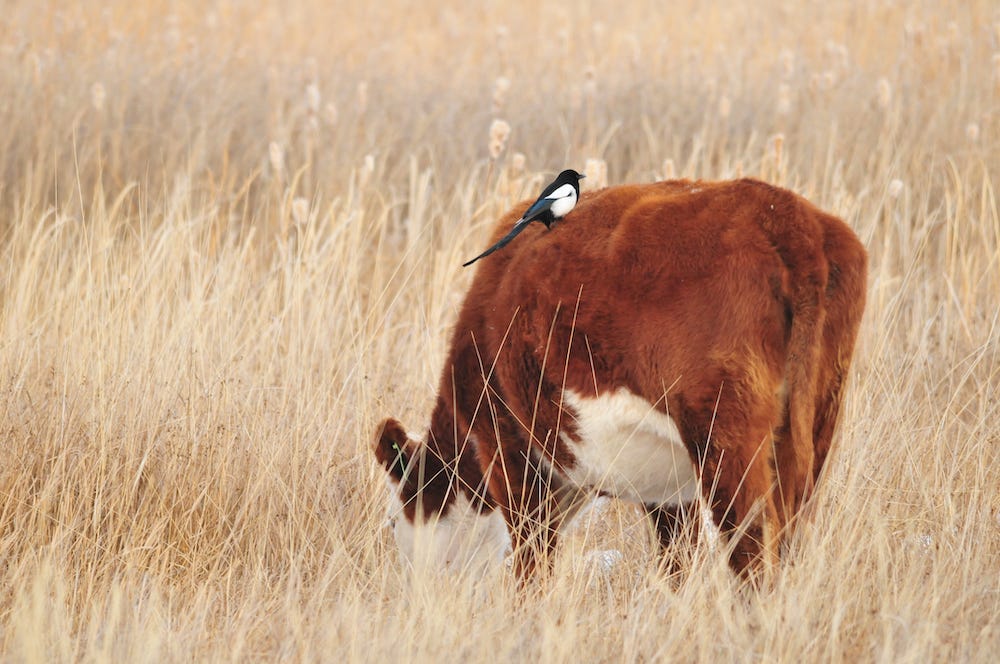
Hellooooooo, TGIF! Or more like TGIB—thank god it’s Bird of the Week! (Yeah yeah I know it doesn’t quite work—it’s Friday, be cool.) Today’s bird falls into one of my favorite categories—a very common bird that I, a genuine bird idiot, have somehow never really thought about but when I look at it I’m like “ohhhh my god where have you been all my life???”
OK, are you ready? Let’s get into it and talk a bit about…..the black-billed magpie.
The suggestion to write about the black-billed magpie came from my friend Kate, who is a keen birder and noticed that these little marvels seemed to be absolutely everywhere when she was in Utah recently. And while I am, as I previously indicated, a genuine bird idiot, I’d like to think that even I would have noticed if a lot of birds that looked like this bird were popping up all around me, because WOW.
Every element here is working at maximum amazingness. The stature, the bill, the black and white and blue that blue oh my lord the blue, the tail????? 15 stars out of 10. (Also the boy magpie and the girl magpie look roughly the same, which is always a plus in birdland to me.)
Here is the magpie in flight. Have you ever seen something so glorious???
As Kate discovered, these magpies are indeed all over Utah. They’re all over the West, actually (though not really in California, which is why I was deprived of them as a child), as far south as New Mexico, as far north as Alaska, and as far east as Manitoba in Canada. They like open spaces rather than dense forests, which probably tells you why they make their home in the West. They also don’t mind being around people, which is lucky for them, because people have food, and magpies love to eat. Look at this list from Cornell!
Like other corvids (members of the jay and crow family), Black-billed Magpies have a wide-ranging diet. They eat wild fruit and grain, as well as grasshoppers and beetles that they find while foraging on the ground (they sometimes find beetles by flipping cow dung). They also kill small mammals such as squirrels and voles, and raid birds’ nests. Carrion is also a main food source, as are the fly maggots found in carrion. Sometimes they steal meat from the kills of coyotes and foxes. Magpies also land atop large animals, such as cows or moose, and pick ticks off them. When they find an abundant food source, magpies will cache food for short periods.
Sometimes they steal meat from the kills of coyotes and foxes. This bird is just walking up to a fox and being like “yeah I’ll take that.” Ice cold. Black-billed magpies are legendary thieves. They even stole food from Lewis and Clark, which I am going to say was an act of anti-colonial resistance. Magpies are comrades!
Here is a video of a magpie posting up to a fox and successfully intimidating the fox into leaving some food on the ground.
You gotta love it.
Magpies also land atop large animals, such as cows or moose, and pick ticks off them.
Here is a picture of that.
‘Nuff said.
As you can probably guess from that video with the fox, the black-billed magpie is a pretty aggressive bird. This is partially because it is also a very devoted family and community bird, and it is eager to protect its turf. From the Anchorage Daily News:
Spring is when the magpies build nests and lay eggs. The eggs hatch by late May, and magpie chicks leave their nests for the first time in mid-June. It is during this period -- when the magpie fledglings are at their most vulnerable -- that the birds' character can change from aloof but loud to just plain hooliganism.
[…] When protecting fledglings -- young birds that have leaped away from their nest but don't quite know how to fly properly -- the little magpie can become a big problem for people and pets. Adults are watchful parents, and anything that gets close to their young usually endures at least a loud squawking, or in some cases, even a full assault with wings, claws and beaks.
Now, this could be a lot worse. The Australian magpie, for instance, is a complete psychopath, attacking people with such gusto that everyone in the country has to gird themselves when “swooping season” comes around. They even target the same people over and over again! The black-billed magpie is mostly just giving you a brushback.
As a member of the corvid family, black-billed magpies are also highly intelligent and emotionally complex. They can recognize themselves in a mirror, they have fabulous memories, and they can even mimic human speech.
Like their fellow corvids, they also have big death rituals. Experts have theorized that they can feel grief, and they conduct a complex ceremony when one of their own dies, as Cornell explains:
One of the most notable Black-billed Magpie behaviors is the so-called “funeral”—when one magpie discovers a dead magpie, it begins calling loudly to attract other magpies. The gathering of raucously calling magpies (up to 40 birds have been observed) may last for 10 to 15 minutes before the birds disperse and fly off silently.
Here’s a sad taste of that if you don’t mind watching sadness.
OK, what else, what else, there is almost too much to say, I am going to have to start rattling through this stuff. Oh, the nests, the nests!!!! Black-billed magpie nests take up to 40 DAYS to complete and they are marvels of construction, built with all sorts of flotsam and jetsom and so sturdily made that they last for years and are even used by other birds when the magpies leave.
Also the males court the females by feeding them food! And they mate for life, and they live in huge magpie groups of fifty magpies or even more, and a group of magpies is called a mischief!!!!
Now for the sadder part: all of these facts, to me, are awesome, but for many many years, they made magpies a major target for human evil. According to Nature, the black-billed magpie “was one of the most vilified birds in North America, if not the world.” What?!?!! It’s true though. From Nature:
Outdoor magazines and books in the mid-20th century frequently accused the magpie of gory, horrific crimes against helpless domestic animals and wildlife. Reading these accounts today, the magpie appears to be the winged equivalent of Darth Vader, or perhaps Hannibal Lecter.
Larry Koller, in his Treasury of Hunting (1965), repeats a common accusation against the bird: “Magpies are small, vicious, Western birds with the sanguinary habit of plucking out eyes of young, newly dropped fawns and kids. Then, in a flock attack, they literally eat the helpless animal alive.”
Outdoor writer Bert Popowski dismissed the eye-eating stories as mere folklore. But he wasn’t defending the magpies. In fact, he doubled down on magpie hatred and sensationalism. “Ounce for ounce they have no peer in cold-blooded rapacity,” he wrote in a chapter descriptively named “Magpies are Murder!” in his book Calling All Varmints.
This was all, essentially, bullshit. But the government signed onto the fantasy and gave the green light for people to kill as many magpies as they could. They would literally pay you to do it. Some places even had contests to see who could kill the most magpies. WTF!
This mostly came to an end after legislation to protect the magpies and other corvids was passed in the 70s, but…my goodness. Since then, though, magpies have been left much more alone (apart from the usual human-caused degradation that is slowly killing all living things, of course).
Let the black-billed magpie be! It is so good! To close things out, here is a video of a magpie just chilling on a car. Joy, joy, joy.
A reminder: you can check out our complete Bird of the Week list here, and get in touch with your bird suggestions at hello@discourseblog.com.






















As someone with a red billed blue magpie tattoo (the south/east asian cousin to the bird of the week) I was very happy to see this. Thank you, as always, for the important bird content.
Next up...Heckle and Jeckle, the talking YELLOW-BILLED magpies.